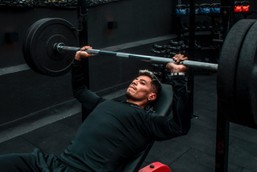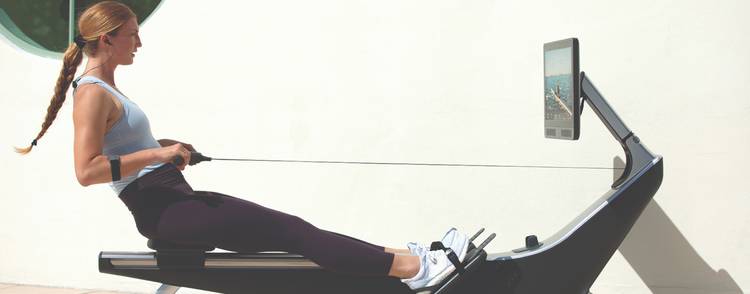
From Barbells to Bumper Plates: A Guide to Starting Your Olympic Weightlifting Journey
Many consider Olympic weightlifting the original strength sport. The first Weightlifting World Championships took place in London in 1891 – long before Powerlifting and Bodybuilding gained popularity. Oly lifting requires a solid mix of strength, power, coordination, and flexibility – that’s a lot to ask from one athlete.
But one of the reasons Olympic lifting is so popular is because it offers tons of health benefits to its athletes. You get a full-body workout, enhanced mobility, explosive power, muscle-building, and fat-burning benefits – all from one lifting style.
In this guide, we’ll cover everything you need to know to get started on your journey to Olympic weightlifting at home, including:
- How to set up your lifting space
- Key pieces of equipment you’ll need
And, most importantly, a step-by-step on how to execute the two Oly lifts: The Snatch and the Clean and Jerk
How to Set Up Your Home Gym for Olympic Weightlifting
After seeing the list of health benefits that come from Olympic lifting, you’re ready to get started. Below we’ll cover what you’ll need to build out your very own home weightlifting gym.
Decide on Your Weightlifting Space
There are two space requirements for creating your Olympic lifting home gym:
- Overhead space: The majority of the Olympic lifts end up over your head. You need to make sure that your arms, the barbell, and the plates clear the ceiling. A good rule of thumb is to have 8ft x 6ft of working space.
- A stable platform: At most commercial weightlifting gyms, you’ll find several solid wooden platforms across the floor. You’re welcome to purchase or DIY one, but for most athletes, a sturdy, stable floor will do. Such as the bare concrete in your garage or basement. If you are looking for gym floor solutions, you can find some here as well.
Find the Right Weightlifting Equipment
Each genre of lifting – i.e. powerlifting, bodybuilding, and Olympic lifting – has different equipment requirements. You might think your standard barbell will work for some Clean & Jerk’s (If you don’t want those are we will be explaining them below). And yes, it will definitely get the job done. But there’s a big difference in the mechanics of a standard barbell vs an Olympic barbell (and a reason the Olympic barbell is best for Olympic lifting).
Below you’ll find a list of essential Olympic weightlifting equipment you can find at Fitness Town:
- Men’s & Women’s Olympic Barbells: Olympic barbell weights differ for men and women. A women’s barbell will weigh 15kg and is roughly 6.5ft long. While a men’s barbell will weigh 20kg and is around 7ft. Keep in mind that men and women can use these barbells interchangeably. Men, you can benefit from practicing on a shorter, lighter bar. Women, test that grip strength on the thicker, heavier men’s barbell. Either way, when investing in an Olympic bar, it’s important to look for high tensile strength, quality knurling, and bushings or bearings in the sleeve collar.
- Squat Rack: Necessary for accessory movements like front squats and presses. Power racks will give you more options, like an attached pull-up bar (for your assistive exercises).
- Plates: We know. Our plate selection can be overwhelming. But when it comes to Olympic lifting, you’ll want bumper plates all the way. They’re made of rubber and designed to withstand a drop (which you’ll want when you have a heavy barbell over your head). Another good tool to have on hand is fractional plates. These weight plates come in small increments which are perfect for helping you hit your new PR.
- Collars: Collars are crucial for keeping your plates in place and on your barbell. The last thing you want is for a plate to slide off the end of your bar mid-set. We carry Lock-Jaw collars, which are the strongest, most durable collars on the market.
- Accessories – Belt & Straps: Weightlifting accessories help you stay safe and strong. Belts protect your back and straps enhance your grip. When used correctly, they can dramatically improve your lifts.
- Weight tree: Weight trees not only help keep your gym floor organized but also help protect your equipment between workouts.
- Optional: Technique bars are lighter (6.8kg/15lbs) and have a barbell length of 6ft vs the 7ft of a traditional Olympic barbell. They’re super beneficial for practicing your form and nailing the mechanics of a lift.
Learning the Basics of Olympic Weightlifting
You’ve decked out your space and primed your muscles (you stretched, right?). So let’s get to lifting.
We can break Olympic lifting down into two main movements: the Clean and Jerk and the Snatch. From those two movements, there are other variations like the Power Clean, Squat Clean, Push Jerk, and Power Snatch.
What is a Clean & Jerk?
You perform the Clean and Jerk in two parts:
1) Lift the barbell from the floor and catch it on your shoulders
2) Execute a “push-press” with the barbell and catch it overhead with locked arms
You can either catch it in a split (the split jerk) or in a squat (the squat jerk). This lift requires power, strength, speed, and a tough collarbone!
To perform a Clean and Jerk:
- Start with your feet hip-width apart and toes facing forward.
- Squat down and find the knurl marks on your barbell. On a double-knurled barbell, grip the bar at the first mark using an overhand hook grip. Keep your shoulders over the barbell (or slightly in front). Your chest should stay up.
- Create some tension on the barbell by pulling your arms straight. Brace your core by taking a deep breath through your stomach. You have your starting position.
- Drive your feet into the ground and explode up with the barbell. When the barbell passes your knees, shrug your shoulders as you jump upward with the barbell, coming up onto your toes.
- Once the barbell reaches its max height, pull yourself under the barbell and catch the barbell on your shoulders. Be careful not to catch on your collarbone!
- Stand up with the barbell. Once you’re standing, tuck your elbows down, chin in, and take another bracing breath.
- Dip your knees slightly as you push hard off the ground and drive the barbell over your head. Jump one foot back and the other forward as you catch the barbell with locked arms.
- Move your back foot forward to meet your front foot. Hold it high for a second, and then safely lower (or drop your bar if you’re using bumper plates…hint: you should be). Congrats! You’ve successfully completed a clean and jerk.
What is a Snatch?
Arguably, Snatching requires the most athletic ability out of any weightlifting movement. During the Snatch, you rip the barbell off the floor and catch it overhead in a deep squat… all in a single movement. This lift requires speed, precision, power, and flexibility.
To perform a Snatch:
- Stand with your feet hip-width apart and your toes turned slightly out. Keep your toes under the barbell.
- Get down into a deep squat until your elbows are in line with your knees. On a double-knurled barbell, wrap your fingers around the second knurl mark using a hook grip. Keep your shoulders directly over the barbell or slightly in front and your chest up.
- With your back flat, chest up, and arms straight, create some tension on the barbell by removing the slack. You’ve found your starting position.
- Keeping your back flat, drive your feet into the ground and stand up. Hard. Imagine you are jumping straight up with the barbell in your hands. Shrug your shoulders and rise to your toes. Do not pull the barbell by bending your elbows.
- Once the barbell has reached its maximum height from your pull, you’re going to drop into a deep squat. As you go underneath the barbell, lock your elbows out and catch the bar over your head.
- Once you’ve gained control, perform an overhead squat with the barbell and stand up.
- Hold it! After sticking the Snatch, you can safely lower the barbell (or drop it if you have bumper plates).
Olympic Weightlifting Assistance Exercises
If you want to become a better Olympic Weightlifter, you have to add in some accessory exercises. These exercises help build the strong foundation needed to properly execute the lifts and are essential for creating explosive power and strength.
Some popular Olympic weightlifting assistance exercises include:
Pull-ups work your lats and lats are super important for Olympic lifting. Lat strength is what helps you keep the barbell close on your pull from the floor.
Box jumps help build the explosive power you need to rip the barbell off the ground. When doing accessory box jumps for Oly lifting, focus on the 1-rep max kind of jumps. Not conditioning box jumps.
The first part of a Clean and Jerk is a front squat. And you have to be able to squat the weight you’re trying to C & J. Adding in front squats helps you build the leg strength necessary for your Olympic lifts.
The Jerk recruits a lot of upper body muscles. Benching helps strengthen your shoulders, chest, and triceps – which all help build a strong jerk.
Final Thoughts on Olympic Lifting
When looking for a sport that offers you a chance to build strength, speed, power, and agility – all in one workout – Olympic weightlifting is hard to beat.
Like any exercise, learning the Olympic lifts will take practice. And having the right equipment and setup at home gives you everything you need to master the technique and reap the benefits.
If you want to test out our collection of Olympic barbells, or ask a weightlifting-related question to one of our experts, visit the Fitness Town store nearest you or call us at 1-855-417-1111.

